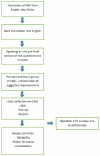Translation and validation of the polish version of the self-reported postural awareness scale in an adult sample
- PMID: 40535194
- PMCID: PMC12174420
- DOI: 10.3389/fpsyg.2025.1554594
Translation and validation of the polish version of the self-reported postural awareness scale in an adult sample
Abstract
Introduction: Body awareness has gained increasing attention in research as a crucial link between psychological and somatic processes, offering tangible benefits for physical health and well-being. This study aimed to validate and culturally adapt the Polish version of the Postural Awareness Scale (PAS) in adults aged 20-70.
Methods: The relationships between the two PAS subscales: Ease/Familiarity with Postural Awareness and Need for Attention Regulation with Postural Awareness, and chronic stress levels (measured by the Perceived Stress Scale, PSS-10), as well as gender, age, and family status (individuals in permanent relationships versus singles), were explored. The factor structure was tested by exploratory and confirmatory factor analysis.
Results and discussion: A total of 333 healthy participants (mean age: 36.74 ± 19.7 years; 76% female) completed the study. Cultural adaptation of the PAS required the removal of one item, resulting in an 11-item Polish version with strong internal consistency (Crohnbach's α: 0.80-0.82) and psychometric properties comparable to the original German version. Multi-group analyses confirmed metric equivalence of the scale across age, gender, and family status. A negative correlation was observed between PAS scores and perceived stress (PSS-10), while no significant associations were found with gender or family status. Older participants exhibited higher scores on the Ease/Familiarity with Postural Awareness subscale. These findings suggest that the Polish version of the PAS is a reliable and valid tool for assessing postural awareness in diverse adult populations, with potential applications in research and clinical practice.
Keywords: body awareness; body posture; body sensations; mindfulness; perceived stress.
Copyright © 2025 Jankowicz-Szymańska, Wódka, Grochowska, Stefanowicz-Kocoł, Bilc, Anheyer, Kozioł, Cramer and Sagan.
Conflict of interest statement
The authors declare that the research was conducted without any relationships that could potentially create a conflict of interest.
Figures
Similar articles
-
Psychometric properties of the Chinese version of the pros and cons of anorexia nervosa (P-CAN-C) scale: a validation study in patients with anorexia nervosa.J Eat Disord. 2025 Jun 16;13(1):111. doi: 10.1186/s40337-025-01314-x. J Eat Disord. 2025. PMID: 40524259 Free PMC article.
-
Psychometric Properties of the Instrument for Scoring Clinical Outcomes of Research for Epidermolysis Bullosa patient score (iscorEB-p): a patient-reported outcome measure.Br J Dermatol. 2024 Jun 20;191(1):75-81. doi: 10.1093/bjd/ljae019. Br J Dermatol. 2024. PMID: 38261404
-
CALCULATION OF TOTAL ENERGY EXPENDITURE IN ADULTS WITH CROHN'S DISEASE BY INDIRECT CALORIMETRY AND SIMPLE WEIGHT-BASED EQUATIONS: A COMPARATIVE STUDY.Arq Gastroenterol. 2025 Jun 16;62:e24122. doi: 10.1590/S0004-2803.24612024-122. eCollection 2025. Arq Gastroenterol. 2025. PMID: 40531684 Free PMC article.
-
Prenatal administration of progestogens for preventing spontaneous preterm birth in women with a multiple pregnancy.Cochrane Database Syst Rev. 2019 Nov 20;2019(11):CD012024. doi: 10.1002/14651858.CD012024.pub3. Cochrane Database Syst Rev. 2019. PMID: 31745984 Free PMC article.
-
Defining disease severity in atopic dermatitis and psoriasis for the application to biomarker research: an interdisciplinary perspective.Br J Dermatol. 2024 Jun 20;191(1):14-23. doi: 10.1093/bjd/ljae080. Br J Dermatol. 2024. PMID: 38419411 Free PMC article. Review.
References
-
- Abdoli M., Scotto Rosato M., Desousa A., Cotrufo P. (2024). Cultural differences in body image: a systematic review. Sociol. Sci. 13:305. doi: 10.3390/socsci13060305, PMID: - DOI
-
- Anderson R. (2006). Body intelligence scale: defining and measuring the intelligence of the body. Humanist. Psychol. 34, 357–367. doi: 10.1207/s15473333thp3404_5 - DOI
-
- Bartlett M. S. (1950). Tests of significance in factor analysis. Br. J. Stat. Psychol. 3, 77–85. doi: 10.1111/j.2044-8317.1950.tb00285.x - DOI
-
- Blaettler L. T., Goméz Penedo J. M., Schwegler K., Egloff N., grosse Holtforth M. (2022). Negative mood regulation expectancies (NMRE) as a moderator of the association between stress and treatment outcomes in interdisciplinary chronic pain treatment. Clin. J. Pain 38, 351–359. doi: 10.1097/AJP.0000000000001020, PMID: - DOI - PubMed
LinkOut - more resources
Full Text Sources



